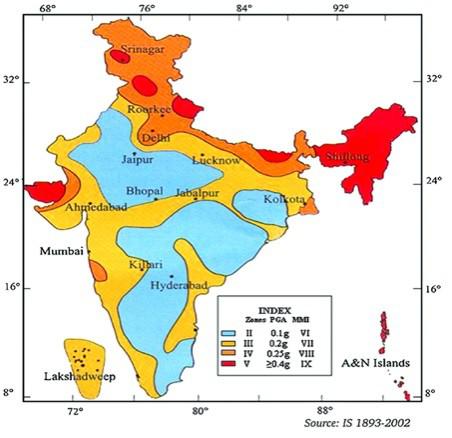Mains Daily Question
Oct. 25, 2023
Q2. Explain the geological and anthropogenic factors that render certain regions in India susceptible to earthquakes. Also, highlight the key components of earthquake management strategy as outlined in the NDMA guidelines that can help enhance the seismic resilience of India.(10M, 150W)
|
Approach to the answer: Understanding and structuring the answer: The question has two main headings: 1) Geological and anthropogenic factors that render certain regions in India susceptible to earthquakes. 2) key components of earthquake management strategy as outlined in the NDMA guidelines Introduction: Mention about earthquake events Body: Heading 1: Geological factors responsible for earthquake in certain regions of India Heading 2: Anthropogenic factors responsible for earthquakes Heading 3: Key components of earthquake management strategy as outlined in the NDMA guidelines Conclusion: Write about the need to create awareness and follow Earthquake management strategies as outlined by the NDMA to decrease the disaster caused by the earthquakes in India. |
Answer: Earthquakes result from a series of earth movements brought about by a sudden release of energy during the tectonic activities in the earth’s crust. As compared to these, the earthquakes associated with volcanic eruption, rock fall, landslides, subsidence, particularly in the mining areas, impounding of dams and reservoirs, etc. have limited area of influence and the scale of damage.
Natural causes of earthquakes
- Accumulation of energy: Due to movement of Indian plate towards Eurasian plate, which results in building up of stress, which ultimately leads to the breaking up of the rock and the sudden release of energy causes earthquakes along the Himalayan arch.
- For example: Associated vulnerable regions are: Jammu and Kashmir, Ladakh, Himachal Pradesh, Uttarakhand, north eastern states,etc.
- Amplification of energy in alluvial plains: Regions like areas of Delhi, that it is in the Gangetic plain and is built on alluvium. As energy passes through soft alluvium, it gets amplified. With more amplification it can cause more damage.
- Emergence of faultline: Theory of emergence of a fault line and energy build-up along the fault line represented by the river Bhima (Krishna) near Latur and Osmanabad (Maharashtra) and the possible breaking down of the Indian plate
- For example, earthquakes in Latur region of Maharashtra.
- Volcanoes are also a reason for earthquakes.
Anthropogenic causes:
- Mining Projects: Mining companies are digging deeper in the earth’s crust than ever before. So many rocks and other materials are being removed from the Earth that instability in the ground is occurring, which is triggering earthquakes.
- Hydropower projects in mountainous areas: Triggering earthquakes due to digging of tunnels, breaking large mountains,etc.
- Dam Building: The construction of dams has caused some of the largest and deadliest human-triggered earthquakes in history.
- For example: reservoir induced seismicity due to Koyna dam. China’s 2008 earthquake in Sichuan province due to a dam project.
- Fracking: Fracking involves injecting liquid at high pressures into subterranean rock in the hopes of forcing open existing fissures for the purpose of extracting oil or gas. This also causes earthquakes.
- Disposal Of Wastewater in fracking: The disposal of waste water produced in the fracking process also causes quakes. This wastewater is the by-product of the sand, water, and chemicals used to fracture hydrocarbons from rock. The high-pressure it causes can lubricate existing faults and crack rocks, triggering earthquakes.
- Nuclear Explosions: earthquakes are also sometimes caused by nuclear explosions.
- For example: North Korea’s 2017 nuclear bomb test set off aftershocks that lasted for about eight months after the explosion.
Key components of Earthquake management strategy as outlined in the NDMA guidelines:
- Earthquake-Resistant Design and Construction of New Structures: There are building codes and other regulations which make it mandatory that all structures in earthquake-prone areas in the country must be built in accordance with earthquake-resistant construction techniques.
- Seismic Strengthening and Retrofitting of Lifeline and Priority Structures: It recommends for the structural safety audit and retrofitting of select critical lifeline structures and high priority buildings. Such selection will be based on considerations such as the degree of risk, the potential loss of life and the estimated financial implications for each structure.
- Regulation and Enforcement: By enacting laws, building codes and ensuring their compliance: This is to ensure that all stakeholders like builders, architects, engineers and government departments, responsible for regulation and enforcement adopt earthquake-safe construction practices and provide for seismic safety in all design and construction activities.
- Creation of Public Awareness on Seismic Safety and Risk Reduction: A comprehensive awareness campaign will be developed and implemented on the safe practices to be followed before, during and after an earthquake.
- Capacity Development: The target groups for capacity development will include elected representatives and government officials, urban planners, engineers, architects and builders. The focus will be on institutionalizing appropriate capacity building mechanisms to ensure seismic safety.
- Earthquake Response: The management and control of the adverse consequences of future earthquakes will require coordinated, prompt and effective response systems at the central and state government levels, especially at the district and the community levels.
It is always the buildings, not earthquakes, that kill people. While we cannot as of now predict and stop Earthquakes, we can certainly make people more aware and follow Earthquake management strategies outlined by the NDMA.


